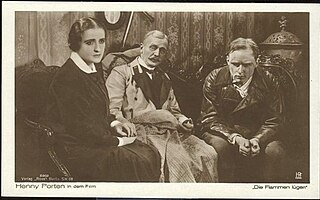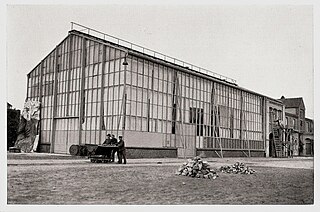UFA GmbH, shortened to UFA, is a film and television production company that unites all production activities of the media conglomerate Bertelsmann in Germany. The original UFA was established as Universum-Film Aktiengesellschaft on December 18, 1917, as a direct response to foreign competition in film and propaganda. UFA was founded by a consortium headed by Emil Georg von Stauß, a former Deutsche Bank board member. In March 1927, Alfred Hugenberg, an influential German media entrepreneur and later Minister of the Economy, Agriculture and Nutrition in Adolf Hitler's cabinet, purchased UFA and transferred ownership of it to the Nazi Party in 1933.

German expressionist cinema was a part of several related creative movements in Germany before the First World War that reached a peak in Berlin during the 1920s. These developments were part of a larger Expressionist movement in north and central European culture in fields such as architecture, dance, painting, sculpture and cinema.

The Zeppelin-Staaken R.VI was a four-engined German biplane strategic bomber of World War I, and the only Riesenflugzeug design built in any quantity.

Erich Pommer was a German-born film producer and executive. Pommer was perhaps the most powerful person in the German and European film industries in the 1920s and early 1930s.

Staaken is a locality at the western rim of Berlin within the borough of Spandau.

The Ghost Train is a 1927 German-British crime comedy film directed by Géza von Bolváry and starring Guy Newall, Ilse Bois and Louis Ralph. It is an adaptation of Arnold Ridley's play The Ghost Train. The film was a co-production between Gainsborough Pictures and Phoebus Film and was shot at the latter's Staaken Studios in Berlin. The film was released in France as Le Train Fantome.

Bavaria Studios are film production studios located in Munich, the capital of the region of Bavaria in Germany, and a subsidiary of Bavaria Film.

The White Peacock is a 1920 German silent drama film directed by Ewald André Dupont and starring Guido Herzfeld, Hans Mierendorff and Karl Platen. It was shot at the Tempelhof Studios in Berlin. The film's sets were designed by the art directors Paul Leni, Robert A. Dietrich and Otto Moldenhauer
The Projektions-AG Union was a German film production company which operated between 1911 and 1924 during the silent era. From 1917 onwards, the company functioned as an independent unit of Universum Film AG, and was eventually merged into it entirely.
Latin Quarter is a 1929 German silent drama film directed by Augusto Genina and starring Gina Manès, Carmen Boni and Helga Thomas. It was based on a novel by Maurice Dekobra. It was shot at the Staaken Studios and on location in Paris. The film's art direction was by Franz Schroedter. It premiered at the Ufa-Palast am Zoo in Berlin.

Tobis Film was a German film production and film distribution company. Founded in the late 1920s as a merger of several companies involved in the switch from silent to sound films, the organisation emerged as a leading German sound studio. Tobis used the Tri-Ergon sound-on-film system under the Tobis-Klang trade name. The UFA production company had separate rights to the Tobis system, which it used under the trade name of Ufa-Klang. Some Tobis films were released in Germany by the subsidiary Europa Film.
The Ship of Lost Souls or The Ship of Lost Men is a 1929 German silent thriller film directed by Maurice Tourneur and starring Fritz Kortner, Marlene Dietrich and Robin Irvine.

The Flames Lie is a 1926 German silent drama film directed by Carl Froelich and starring Hans Adalbert Schlettow, Ruth Weyher and Henny Porten. It was shot at the Staaken Studios in Berlin. The film's sets were designed by Franz Schroedter. It was made by UFA and released under the Parufamet agreement.

The Tempelhof Studios are a film studio located in Tempelhof in the German capital of Berlin. They were founded in 1912, during the silent era, by German film pioneer Alfred Duskes, who built a glass-roofed studio on the site with financial backing from the French company Pathé. The producer Paul Davidson's PAGU then took control and constructed a grander structure. The First World War propaganda drama The Yellow Passport, the historical comedy Madame DuBarry and the expressionist 1920 silent film The Golem were made there by PAGU.
The Althoff Studios were film studios located in Potsdam outside the German capital Berlin.

The Dancer of Sanssouci is a 1932 German historical drama film directed by Frederic Zelnik and starring Otto Gebühr, Lil Dagover, and Rosa Valetti. Set at the court of Frederick the Great, the film is part of a group of Prussian films made during the era. It portrays the interaction between Frederick and the celebrated dancer Barberina Campanini. Gebühr had previously appeared as Frederick in a silent film The Dancer Barberina about their relationship.

The Weissensee Studios was a collection of separate film production studios located in the Berlin suburb of Weißensee during the silent era.
The Johannisthal Studios were film studios located in the Berlin area of Johannisthal. Founded in 1920 on the site of a former airfield, they were a centre of production during the Weimar and Nazi eras. Nearly four hundred films were made at Johannistal during the silent period. The first production was the 1920 silent Verkommen starring Maria Zelenka. Sometimes known as the Jofa Studios, in 1929 they became the base of the newly established German major studio Tobis Film at the beginning of the sound era.

The Hostivař Studios are film studios located in the Hostivař district in Prague, Czech Republic. Founded in 1934, the studios cover an area of about 20,000 square metres.

The Terra Studios or Marienfelde Studios were film studios located in the Berlin suburb of Marienfelde.













